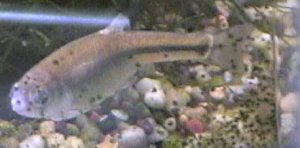
Human Uses
1. Biotoxicity Testing:
Fathead minnows are used in biotoxicity tests. Ten newborns are
placed into containers with the client's water. After a week, any
survivors are killed and weighed. The number of survivors and their
weight is directly proportional to the toxicity of the water.
2. Bait:
Fathead minnows and sometimes rosy red minnows are sold as bait to
hook onto lines to catch larger fish. Many anglers only learn about
small fish as bait.
3. "Feeder fish":
Rosy red minnows are quickly competing with goldfish as the "feeder
fish." Since they breed so well, rosy reds are sold in large
quantities for $1 a dozen to be fed to other animals. Piranha, oscars, other large piscivorus and omnivorous fish, aquatic turtles,
water snakes, semi-aquatic lizards, and other animals all may eat
these fish. Since they stay smaller than goldfish, they are
better suited to feeding smaller animals. Unfortunately, due to their poor care,
"feeder fish" are usually infested with parasites, bacteria, and
diseases.
 4. Aquarium fish:
4. Aquarium fish:
A few aquarists keep rosy red and/or fathead minnows in aquariums to
admire them for themselves.
5. Pond fish:
Fathead minnows are being more
frequently added to ponds. They are added as dither fish to make
larger fish (koi and goldfish) less cautious and more active. They
are added to provide a constant food supply for larger fish (orfe,
game fish), turtles, and predators (the raccoon will take a tasty
rosy red any day). They are added to make the pond seem more alive.
They are added to provide movement during the winter when larger
fish are resting (rosy reds like to cruise under the ice). They are
added when the pond is simply too small (tub gardens, etc.) for
larger goldfish or koi.
Along with these uses are 11 reasons fathead minnows are GREAT!
Home University of Wisconsin LaCrosse MultipleOrganisms.net